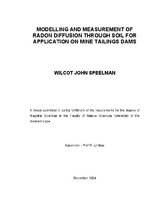| dc.contributor.advisor | Lindsay, R. | |
| dc.contributor.author | Speelman, Wilcot John | |
| dc.contributor.other | Dept. of Physics | |
| dc.contributor.other | Faculty of Science | |
| dc.date.accessioned | 2013-08-06T12:34:43Z | |
| dc.date.available | 2007/05/04 14:49 | |
| dc.date.available | 2007/05/04 | |
| dc.date.available | 2013-08-06T12:34:43Z | |
| dc.date.issued | 2004 | |
| dc.identifier.uri | http://hdl.handle.net/11394/1795 | |
| dc.description | Magister Scientiae - MSc | en_US |
| dc.description.abstract | Radon has been identified as an important factor that could result in a health hazard by studies all around the world. The health risks can be minimised by preventive measures where radon is highly concentrated as in some mines and homes. Measuring and modelling the radon concentrations in the mine dump soil, can help to deduce the radon flux to identify the problem areas for rehabilitation especially in the cases of gold and uranium mine tailings. Rehabilitation in those cases usually consists of a multilayer cover of solids like crushed rock or clay. A passive method incorporating electret technology was used in this study to determine the radon emanation coefficient of the soil. This investigation also describes the modelling of a depth profile with respect to the radon activity concentration to understand from how deep radon might be migrating, as well as the effect of different diffusion lengths. | en_US |
| dc.language.iso | en | en_US |
| dc.publisher | University of the Western Cape | en_US |
| dc.subject | Radon | en_US |
| dc.subject | Measurement | en_US |
| dc.subject | Environmental aspects | en_US |
| dc.title | Modelling and measurement of radon diffusion through soil for application on mine tailings dam | en_US |
| dc.type | Thesis | en_US |
| dc.rights.holder | University of the Western Cape | en_US |
| dc.description.country | South Africa | |

